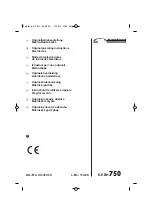
4
INTRODUCTION
Prior to initial start-up of the 19MV unit, those involved in the
start-up, operation, and maintenance should be thoroughly famil-
iar with these instructions and other necessary job data. Proce-
dures in this manual are arranged in the sequence required for
proper chiller start-up and operation. This book also outlines the
control system for those involved in the start-up, operation and
maintenance of the unit before performing start-up procedures. It
is intended to be used in combination with the 19MV Semi-Her-
metic Centrifugal Liquid Chillers Controls Operation and Trou-
bleshooting manual that describes the controls in detail.
ABBREVIATIONS AND EXPLANATIONS
Factory-installed additional components are referred to as options
in this manual; factory-supplied but field-installed additional com-
ponents are referred to as accessories.
Frequently used abbreviations in this manual include:
CHILLER FAMILIARIZATION (Fig. 1 and 2)
Chiller Information Nameplate
The information nameplate is located on the left side of the chiller
power panel.
System Components
The main components include the evaporator and condenser heat
exchangers in separate vessels, motor-compressor, refrigerant,
power panel, PIC6 Touch Screen HMI, economizer, VFD, UPS,
and MBC.
Evaporator
This vessel is located underneath the compressor. The evaporator
is maintained at a lower temperature/pressure so evaporating re-
frigerant can remove heat from water or brine flowing through its
internal tubes. Water flows through the internal tubes to provide
comfort or process cooling.
Condenser
The condenser operates at a higher temperature/pressure than the
evaporator and has water flowing through its internal tubes in or-
der to remove heat from the refrigerant.
Economizer Option
The 19MV system utilizes a BPHX to transfer heat from the
main stream of liquid refrigerant to a smaller stream of refriger-
ant, which has been brought to an intermediate pressure by use
of an EXV. The intermediate pressure refrigerant leaves the
BPHX as a superheated vapor and flows into the second stage
end of the compressor. The heat removed by the vaporized re-
frigerant in the economizer allows the liquid refrigerant in the
evaporator to absorb more heat when it evaporates and benefits
the overall cooling efficiency cycle. See Fig. 3 for economizer
assembly details.
CAUTION
Do NOT punch holes or drill into the top surface of the control
or VFD enclosure for field wiring. Knockouts are provided for
field wiring connections. Drilling holes through the top of the
cabinet can result in a loss of warranty on the starter assembly
because of metal particulate falling on and into electronic
components.
CAUTION
PROVIDE MACHINE PROTECTION. Store machine and
starter indoors, protected from construction dirt and moisture.
Inspect under shipping tarps, bags, or crates to be sure water
has not collected during transit. Keep protective shipping
covers in place until machine is ready for installation. Follow
latest Water-Cooled Chillers Long Term Storage document
located in Chiller Builder Library.
CAUTION
WHEN FLUSHING THE WATER SYSTEMS isolate the
chiller from the water circuits to prevent damage to the heat
exchanger tubes.
CAUTION
This unit uses a microprocessor control system. Do not short
or jumper between terminations on circuit boards or modules;
control or board failure may result.
Be aware of electrostatic discharge (static electricity) when
handling or making contact with circuit boards or module
connections. Always touch a chassis (grounded) part to
dissipate body electrostatic charge before working inside
control center or use a grounding strap before handling printed
circuit boards.
Use extreme care when handling tools near boards and when
connecting or disconnecting terminal plugs. Circuit boards can
easily be damaged. Always hold boards by the edges and
avoid touching components and connections.
This equipment uses, and can radiate, radio frequency energy.
If not installed and used in accordance with the instruction
manual, it may cause interference to radio communications.
The PIC6 control boards have been tested and found to
comply with the limits for a Class A computing device
pursuant to International Standard in North America EN
61000-2/3 which are designed to provide reasonable
protection against such interference when operated in a
commercial environment. Operation of this equipment in a
residential area is likely to cause interference, in which case
the user, at his own expense, will be required to take whatever
measures may be required to correct the interference.
Always store and transport replacement or defective boards in
anti-static shipping bag.
AWG
—
American Wire Gage
BMS
—
Building Management System
BPHX
—
Braised Plate Heat Exchanger
CCN
—
Carrier Comfort Network
®
DCIB
—
Digital Control Interface Board
DVM
—
Digital Volt-Ohmmeter
ECDW
—
Entering Condenser Water
ECW
—
Entering Chilled Water
EMS
—
Energy Management System
EXV
—
Electronic Expansion Valve
HMI
—
Human Machine Interface
HVIB
—
High Voltage Interface Board
I/O
—
Input/Output
ICP
—
Interstage Compressor Piping
IGBT
—
Insulated-Gate Bipolar Transistor
IGV
—
Inlet Guide Vane
IOB
—
Input Output Board
LCDW
—
Leaving Condenser Water
LCW
—
Leaving Chilled Water
LED
—
Light-Emitting Diode
MAWP
—
Maximum Allowable Working Pressure
MBC
—
Magnetic Bearing Controller
NSTV
—
Network Service Tool V
OLTA
—
Overload Trip Amps
PIC
—
Product Integrated Controls
PPE
—
Protective Personal Equipment
PWM
—
Pulse Width Modulating
RLA
—
Rated Load Amps
RMS
—
Root Mean Square
SCCR
—
Short Circuit Current Rating
SCR
—
Silicon Controlled Rectifier
SIOB
—
Starfire 2 Input Output Board
UPS
—
Uninterruptible Power Supply
VFD
—
Variable Frequency Drive
VPF
—
Variable Primary Flow
Содержание AquaEdge 19MV
Страница 49: ...49 Fig 46 SIOB...
Страница 50: ...50 Fig 47 IOB2...
Страница 51: ...51 Fig 48 19MV Auxiliary Controls Wiring...
Страница 52: ...52 Fig 49 Motor Bearing Control Board Wiring...





































